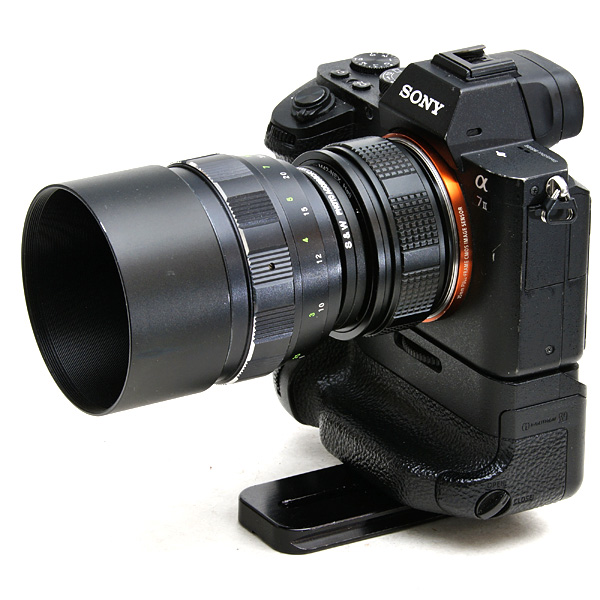The following was published @ DPreview.com on August 22, 2019 and slightly modified.
============================
Ricoh made an odd camera 126C-Flex TLS around 1969. Click here for its manual in PDF. This camera was odd because it used the Kodak 126 film (26.5 x 26.5mm) and in camera aperture mechanism. This Ricoh 126c Reflex has shutter priority and manual exposure modes. The lens mount has a thick extruding disc for setting shutter speed for the meter to set aperture. On the right side of the camera front there is a Auto/Manual ring. Setting to Auto A the camera is in the shutter priority mode, and setting an aperture value such as 1/60s, the camera is in manual mode and the user uses the front shutter ring to set shutter speed. The camera meter reports whether the setting is "good" or not.
I am not interested in this very basic camera body, and I am only interested in its 100mm 1:2.8. The manual mentioned above indicated that there are three lenses available: 55mm 1:2.8, 35mm 1:2.8 and 100mm 1:2.8. The latter two seem to be rather uncommon.
The following images show the lens front and rear. The first impression when looking at the front of this lens was that it is huge compared to other 100/2.8 lenses such as Nikon E 100mm 1:2.8 and Pentax M42 105mm 1:2.8. The Nikon takes 52mm filters but this Ricoh requies 67mm just 5mm smaller than the Nikon AF-D 105mm 1:2 DC (72mm).


On the other hand, the rear of the lens is rather small. The short protruding tube is to be inserted into the center opening of the shutter speed ring in which houses also aperture mechanism.
To adapt this lens, I must know the thread size at the rear of the lens. Fortunately, it is 30mm. So, I need the following rings to mount this lens to a M42 helicoid for focusing and to adjust for correct flange distance. The following image show a 37-30mm step down ring, a 52-37mm step down ring. These two provide a 52mm male thread. Then, I need 42-52mm step-up ring which provides a M42 male thread.


With a thicker M42 helicoid, the lens can be mounted to my Sony A7II and can focus to infinity by adjusting the helicoid. Note that the lens is always set to infinity and focusing is done with the helicoid. I also need a lens hood to cut down the impact of flare and ghost. In this case, a sort 67mm lens hood is added.


Note that this lens does not have an aperture ring and has to be shot wide open at f/2.8. The minimum focus distance is 2 meters, rather standard for portrait shooting although I do think it is a little bit longer than expected. On the other hand, with a helicoid I can go much closer. I always set the focus to infinity and use the helicoid for focusing. It is also important to point out that this lens uses unit-focus, meaning the WHOLE lens is moved in and out for focusing. Thus, moving the optic part by the lens focus ring and moving the optic part by the added helicoid do not make any difference.
I took this lens for a very short spin as it was very late yesterday, around 8pm. So, lighting is definitely not perfect. The following images were taken straight out of my Sony A7II. Because this lens is not sharp and of low contrast, I used Auto Level followed by a Shadow/Lighting if Auto-Level could erase details, saturation increased, and finally a moderate sharpening. Sorry for not being able to provide you with full resolution images as I need a place to host these larger size images. These images were reduced to 600x400.





It is obvious that this lens is not sharp and of low contrast. This makes focusing rather difficult because I do not know when the subject is in focus.
The bokeh quality of this lens is at best below average. The following is an out-of-focus shot of a digital clock. The is even more significant than what a mirror lens can produce!

This one shows flare (upper right) and ghost (lower left). Bokeh can be rather bad.




But, sometimes bokeh is not so bad if the scene does not have many small bright spots.



Not sure you will like this lens. To me, it is just an odd lens and could produce rather ugly bokeh. The more important part is that it is very not sharp and of low contrast.
Hope the above information helps.
CK
=====================================
***A full review of this lens can be found here, which is a direct translation from my article in Chinese.